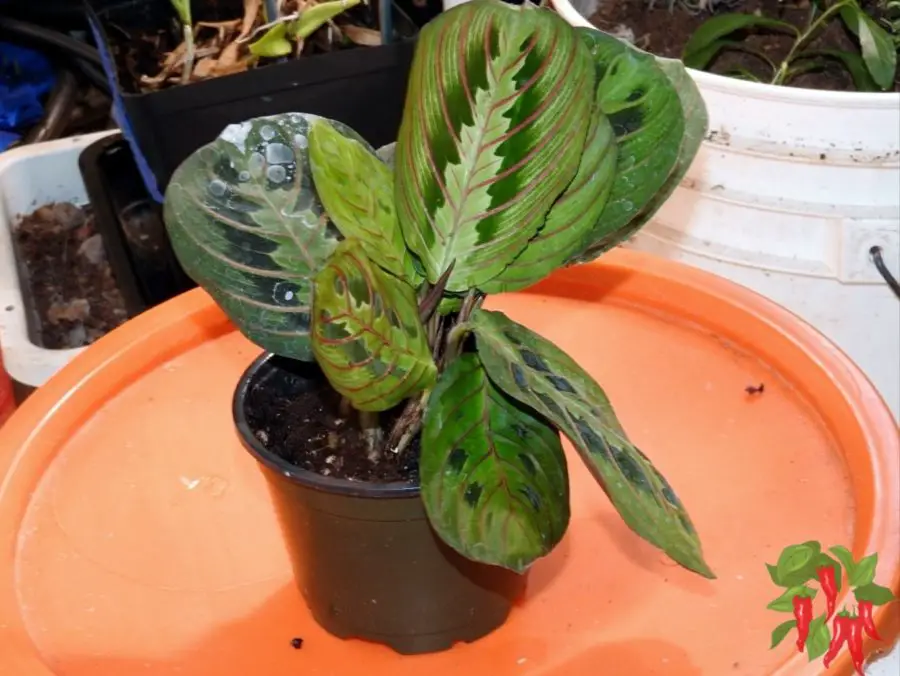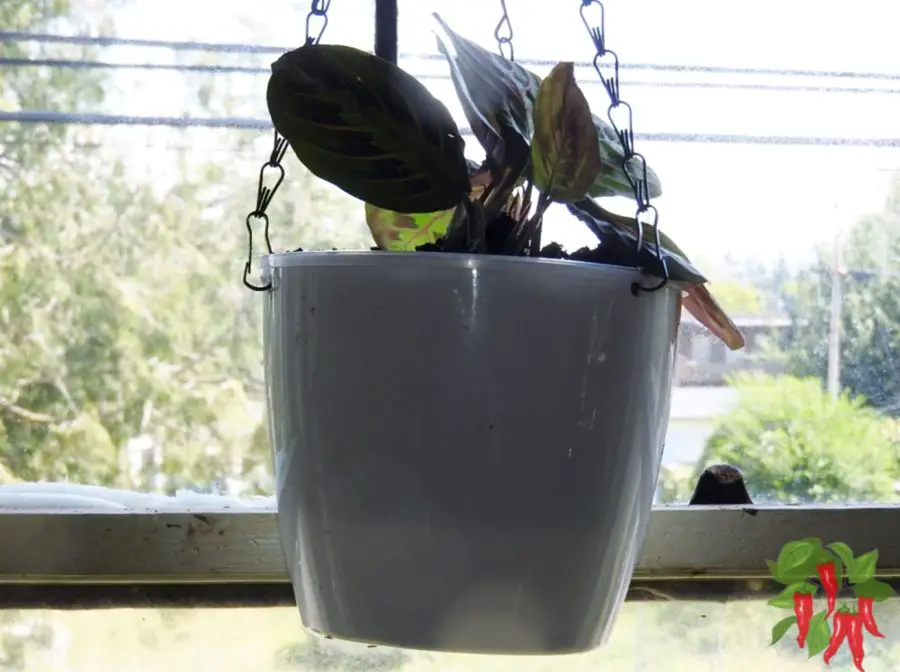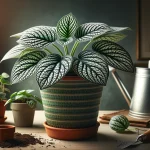This post may contain affiliate links. If you buy something from one of our links we may earn a commission. Thanks

Learning How To Care for a Prayer Plant might seem tricky, but it’s actually quite simple once you know the basics.
These beautiful tropical plants can add a touch of nature to any indoor space.
With the right Prayer Plant care indoors, you’ll have a thriving, eye-catching houseplant that’ll impress your friends and family.
Prayer Plant Care Indoors Key Takeaways
- Keep your Prayer Plant in bright, indirect light and maintain high humidity.
- Water when the top inch of soil feels dry, using room temperature water.
- Fertilize monthly during the growing season and keep temperatures between 60-80°F.
- Regularly clean leaves and watch for pest issues.
How To Care for a Prayer Plant: Prayer Plant Care Indoors
Prayer Plants are stunning houseplants that add a touch of tropical flair to any room.
With their eye-catching leaf patterns and unique habit of folding up their leaves at night, these plants are sure to grab attention.
In this guide, we’ll walk you through everything you need to know about caring for your prayer plant indoors.
1. Introduction to Prayer Plants
 Rooted Red Prayer Plant, Maranta Leuconeura, Live, Easy to Grow
Rooted Red Prayer Plant, Maranta Leuconeura, Live, Easy to Grow
Prayer Plants, scientifically known as Maranta leuconeura, are native to the tropical forests of Brazil.
They get their common name from the way their leaves fold up at night, resembling hands in prayer.
These low-growing plants are perfect for small spaces and make great tabletop or hanging plants.
I got my Red Maranta Prayer Plant on Amazon. It shipped fast, was expertly packed, and was a healthy well rooted plant.
Maranta leuconeura, widely known as the prayer plant due to its daily sunlight-dependent movements (which are said to resemble hands “in-prayer”), is a species of flowering plant in the family Marantaceae native to the Brazilian tropical forests.[1] It is a variable, rhizomatous perennial, growing to 30 cm (12 in) tall and broad, with crowded clumps of evergreen, strikingly-marked oval leaves, each up to 12 cm (5 in) long. The plant spreads itself horizontally, carpeting an entire small area of forest floor, sending roots into the substrate at each leaf node. https://en.wikipedia.org/wiki/Maranta_leuconeura
I remember when I first got my prayer plant. I was drawn to its vibrant green leaves with deep red veins.
Little did I know that this plant would become one of my favorites, not just for its looks but for its fascinating movement.
2. How to Care for a Prayer Plant
Taking care of a prayer plant isn’t rocket science, but it does require some attention to detail. Let’s break down the key aspects of prayer plant care.
Light Requirements
Prayer Plants thrive in bright, indirect light. They’re not sun-worshippers, so keep them away from direct sunlight.
I learned this the hard way when I left my prayer plant on a sunny windowsill for a day. The leaves got scorched, and it took weeks for the plant to recover.
A spot near a north or east-facing window is ideal. If you only have south or west-facing windows, use a sheer curtain to filter the light. Your prayer plant will thank you by showing off its vibrant colors.
Watering
When it comes to watering, Prayer Plants can be a bit picky. They like their soil to be consistently moist but not waterlogged. I water mine when the top inch of soil feels dry to the touch.
Here’s a tip: Prayer Plants are sensitive to chemicals in tap water. If you notice brown tips on the leaves, try using filtered or distilled water. I collect rainwater for my plants, and they seem to love it.
Self-Watering Planters for Prayer Plants

Self-watering planters can be a game-changer for Prayer Plant care, especially if you’re often busy or tend to forget regular watering.
These clever pots can help maintain consistent moisture levels, which Prayer Plants love.
How Self-Watering Planters Work
Self-watering planters typically have two main parts:
1. An upper chamber where the plant and soil sit
2. A lower reservoir that holds water
A wick or capillary system draws water from the reservoir into the soil as needed. It’s like having a built-in plant sitter!
Benefits for Prayer Plants
• Consistent Moisture: Prayer Plants like consistently moist soil, which self-watering planters provide.
• Less Frequent Watering: You might only need to refill the reservoir every 1-2 weeks, depending on the pot size and plant needs.
• Reduced Risk of Overwatering: The plant only takes up what it needs, helping prevent root rot.
I switched my Prayer Plant to a self-watering pot last year, and it’s been thriving. The leaves are more vibrant, and I’ve noticed faster growth.
Plus, it’s been a relief not to worry about watering schedules during busy weeks.
Choosing a Self-Watering Planter
 Hanging Planter Self Watering 10 Inch, 2 Pack Indoor Outdoor Hanging Baskets
Hanging Planter Self Watering 10 Inch, 2 Pack Indoor Outdoor Hanging Baskets
When picking a self-watering planter for your Prayer Plant, consider:
• Size: Choose a pot that’s slightly larger than your plant’s current container.
• Material: Ceramic or plastic both work well. Just make sure there’s a way to monitor water levels in the reservoir.
• Drainage: Even with self-watering pots, good drainage is crucial. Look for ones with overflow holes.
Using Self-Watering Planters
While these planters are great, they’re not entirely hands-off:
• Check water levels regularly and refill as needed.
• Every few months, flush the soil thoroughly with regular watering to prevent salt buildup from fertilizers.
• Clean the reservoir occasionally to prevent algae growth.
Grower Tip:
Make sure your soil is moist when adding a plant to a self watering planter otherwise it may not wick moisture well. I top water my plants to fill the reservoir the first time.
Remember, while self-watering planters can make Prayer Plant care easier, they don’t replace all care needs. You’ll still need to manage light, humidity, and other factors for a healthy plant.
If you’re like me and sometimes forget to water, or if you travel often, a self-watering planter could be a great solution for your Prayer Plant. It’s been a real plant-saver in my home!
Humidity and Temperature
Prayer Plants are tropical divas that love humidity. If your home is dry, especially in winter, your plant might need a humidity boost.
You can use a pebble tray, a small humidifier, or group it with other plants to increase moisture in the air.
As for temperature, keep your prayer plant between 65°F and 85°F. They’re not frost-hardy, so keep them away from cold drafts and air conditioning vents.
Soil and Potting
For happy Prayer Plants, use a well-draining potting mix. I prefer a coco coir mix with some perlite to improve drainage and retain moisture. Make sure your pot has drainage holes to prevent root rot.
3. Prayer Plant Care Indoors
Positioning in the Home
Finding the right spot for your prayer plant can make all the difference. I keep mine on a shelf near an east-facing window, where it gets plenty of bright, indirect light and a bit of morning sunshine.
Avoid placing them near heating or cooling vents, as sudden temperature changes can stress the plant.
Seasonal Care Adjustments
As the seasons change, so should your care routine. In spring and summer, when the plant is actively growing, I water more frequently and fertilize every two weeks. Come fall and winter, I cut back on watering and stop fertilizing altogether.
4. Common Prayer Plant Problems
Like any houseplant, Prayer Plants can face some challenges. But don’t worry, most issues are easy to fix if caught early.
Pests
Keep an eye out for common houseplant pests like spider mites and mealybugs. These tiny invaders can quickly take over if not dealt with promptly.
I check my plants weekly, paying special attention to the undersides of leaves where pests often hide.
If you spot any unwelcome guests, treat them with neem oil or insecticidal soap. I prefer neem oil because it’s natural and effective against a wide range of pests.
Diseases
Fungal issues like root rot can occur if the soil stays too wet. To prevent this, make sure your pot has good drainage and avoid overwatering.
If you notice yellowing leaves or a musty smell, it might be time to check the roots and repot if necessary.
Nutrient Deficiencies
Prayer Plants benefit from regular fertilizing during the growing season. I use a balanced, water-soluble fertilizer diluted to half strength every two weeks.
If you notice pale leaves or slow growth, your plant might need a nutrient boost.
5. Prayer Plant Leaves Curling
Curling leaves on a prayer plant can be a sign of several issues. It could be due to low humidity, underwatering, or exposure to cold drafts. In my experience, increasing humidity often solves the problem.
I once noticed my prayer plant’s leaves curling and crisping at the edges. After some investigation, I realized the plant was too close to a heating vent. Moving it to a more humid spot and misting it regularly helped the leaves unfurl within a week.
6. How to Revive a Prayer Plant
If your prayer plant is looking a bit worse for wear, don’t give up hope. Start by checking the basics: light, water, and humidity. Often, adjusting these factors can bring a plant back from the brink.
If the plant is severely affected, you might need to take more drastic measures. I’ve successfully revived a neglected prayer plant by trimming off dead leaves, repotting in fresh soil, and placing it in a makeshift greenhouse (a clear plastic bag over the plant) to increase humidity.
7. Propagating Your Prayer Plant
Propagating Prayer Plants is a fun and easy way to expand your plant collection or share with friends.
It’s also a great way to save a leggy or overgrown plant. Let’s dive into how you can create new Prayer Plants from your existing one.
Methods of Propagation
There are two main ways to propagate Prayer Plants: stem cuttings and division. Both methods are pretty straightforward, even for beginners.
Stem Cutting Propagation
This is my go-to method when I want to create new plants without disturbing the parent plant.
1. Choose a healthy stem with at least two leaves.
2. Cut the stem just below a node (where leaves attach to the stem) using clean, sharp scissors.
3. Remove the lower leaves, leaving the top 1-2 leaves intact.
4. Place the cutting in a clear glass of water, making sure the node is submerged.
5. Change the water every few days to keep it fresh.
6. Once roots are about 1-2 inches long (usually in 2-3 weeks), plant the cutting in moist potting soil.
I’ve had great success with this method. Last spring, I propagated three cuttings from my overgrown Prayer Plant, and now I have beautiful new plants decorating different rooms in my house.
Division Propagation
This method works well when you’re repotting a mature, bushy Prayer Plant.
1. Gently remove the plant from its pot.
2. Carefully separate the root ball into two or more sections, each with healthy roots and stems.
3. Plant each section in its own pot with fresh potting soil.
4. Water well and keep in a warm, humid spot until new growth appears.
I used this method when my Prayer Plant had outgrown its pot. Instead of one overcrowded plant, I ended up with two healthy, full plants.
Care for New Plants
Newly propagated plants need a little extra TLC:
• Keep them in a warm, humid environment.
• Provide bright, indirect light.
• Keep the soil consistently moist but not waterlogged.
• Hold off on fertilizing until you see new growth.
Propagation is a rewarding process that allows you to watch your plant family grow. Plus, there’s something special about nurturing a new plant from start to finish. Give it a try – you might find it’s your new favorite part of plant care!
8. Repotting Your Prayer Plant
Repotting is an important part of Prayer Plant care. These plants typically need repotting every 1-2 years, or when they outgrow their current container. Here’s how to do it:
When to Repot
You’ll know it’s time to repot when you see roots growing out of the drainage holes or when the plant seems to dry out quickly after watering. Spring is the best time to repot, as the plant is entering its active growing season.
Choosing a New Pot
Pick a pot that’s about 1-2 inches larger in diameter than the current one. Make sure it has drainage holes – Prayer Plants hate sitting in water!
Repotting Process
1. Gently remove the plant from its current pot.
2. Shake off excess soil and untangle any circling roots.
3. Place fresh, well-draining potting mix in the new pot.
4. Set your Prayer Plant in the new pot at the same depth it was before.
5. Fill in around the roots with more potting mix.
6. Water thoroughly and place in a spot with bright, indirect light.
I remember the first time I repotted my Prayer Plant. I was nervous, but it was easier than I thought. The plant perked up within a week, putting out new growth like crazy!
9. Pruning and Maintenance
Regular pruning and maintenance keep your Prayer Plant looking its best and encourage healthy growth. Here’s what you need to know:
Why Prune?
Pruning helps maintain the plant’s shape, removes damaged or diseased parts, and stimulates new growth. It’s also a great way to propagate new plants!
When to Prune
The best time to prune is in early spring, just as new growth is beginning. However, you can remove dead or yellowing leaves any time of year.
How to Prune
1. Use clean, sharp scissors or pruning shears.
2. Cut stems just above a leaf node (where a leaf attaches to the stem).
3. Remove any dead, yellowing, or damaged leaves.
4. Trim leggy stems to encourage bushier growth.
Maintenance Tips
• Dust leaves regularly with a soft, damp cloth to keep them clean and pest-free.
• Rotate your plant every few weeks to ensure even growth.
• Check for pests weekly, especially under the leaves.
• Pinch off any flower stalks – while pretty, they take energy away from leaf growth.
I make pruning part of my regular plant care routine. Every few weeks, I give my Prayer Plant a quick once-over, removing any yellow leaves and trimming any overly long stems.
It’s a relaxing process, and it’s satisfying to see how tidier and healthier the plant looks afterward.
Remember, a little regular care goes a long way in keeping your Prayer Plant happy and thriving!
10. Advanced Prayer Plant Care Tips
Once you’ve mastered the basics, you might want to try your hand at propagation. Prayer Plants are easy to propagate through stem cuttings or division.
To propagate by division, simply separate a healthy section of the plant with roots attached during repotting. For stem cuttings, snip a healthy stem below a node and root it in water or moist soil.
Pruning can help keep your prayer plant bushy and full. I pinch off leggy growth and remove any yellowing or damaged leaves to encourage new growth.
Certainly! I’ll add sections on repotting and pruning/maintenance. Here they are:
Prayer Plant Care Indoors FAQs
What should I do if my Prayer Plant’s leaves are fading?
Fading leaves often indicate too much direct sunlight. Move your plant to a spot with bright, indirect light.
Can I grow Prayer Plants in low light conditions?
While Prayer Plants can tolerate low light, they won’t thrive. You might see slower growth and less vibrant colors.
How often should I fertilize my Prayer Plant?
Fertilize every two weeks during the growing season (spring and summer) with a balanced, water-soluble fertilizer diluted to half strength.
How do you take care of a prayer plant indoors?
Provide bright, indirect light, keep the soil consistently moist, maintain high humidity, and fertilize regularly during the growing season.
How often do you water a prayer plant?
Water when the top inch of soil feels dry. This could be once or twice a week, depending on your home’s conditions.
Where is the best place to put a prayer plant?
Near an east-facing window or a few feet away from a south-facing window with filtered light is ideal.
Do Prayer Plants like to be misted?
Yes, Prayer Plants enjoy misting. It helps increase humidity, which they love.
How do you perk up a prayer plant?
Increase humidity, ensure it’s getting enough (but not too much) light, and check your watering routine. A good feeding might also help.
What does an overwatered prayer plant look like?
An overwatered prayer plant may have yellowing leaves, soggy soil, and a generally droopy appearance.
Can I put my prayer plant outside?
You can move your prayer plant outdoors during warm months, but keep it in a shaded area and bring it back inside before temperatures drop below 60°F.
How to keep Prayer Plants bushy?
Regular pruning and pinching off leggy growth will encourage bushier growth.
How To Care for a Prayer Plant Conclusion
Caring for a prayer plant can be a rewarding experience. These beautiful plants add a tropical touch to any indoor space and their daily leaf movements are truly fascinating to watch.
With the right care, your prayer plant will thrive, providing you with lush, colorful foliage year-round.
Wrapping Up Your Prayer Plant Care Journey
Now that you’ve learned how to care for a Prayer Plant, you’re well on your way to becoming a plant parent pro. Remember, every plant is unique, so don’t be afraid to adjust your care routine as needed.
Key Takeaways
Here are the main points to remember for successful Prayer Plant care:
• Provide bright, indirect light
• Keep soil consistently moist but not waterlogged
• Maintain high humidity
• Use well-draining, nutrient-rich soil
• Fertilize regularly during the growing season
• Watch for common pests and diseases
Troubleshooting Common Issues
If you run into problems with your Prayer Plant, don’t panic. Most issues can be resolved with a few simple adjustments:
• Curling leaves? Check humidity levels
• Yellow leaves? Adjust your watering routine
• Fading color? Ensure proper lighting
Enjoying Your Prayer Plant
With proper care, your Prayer Plant will reward you with lush, colorful foliage and its unique nightly leaf movements.
Take time to appreciate the beauty of your plant and the calming presence it brings to your home.
Remember, every plant is unique and may need slight adjustments to care based on your specific home environment. Don’t be afraid to experiment a little to find what works best for your prayer plant.
Remember, plant care is a journey, not a destination. Enjoy the process of learning and growing alongside your Prayer Plant. Happy gardening!
Read more: Indoor Apartment Gardening: 15 Point Comprehensive Guide
Visit my Amazon Influencer Page for videos and gardening products Grow Your Own Garden









